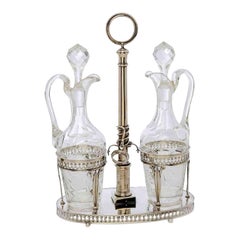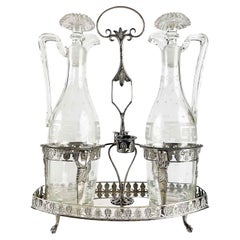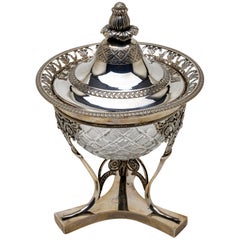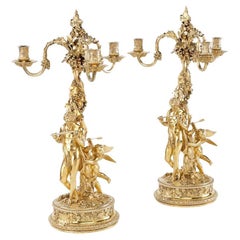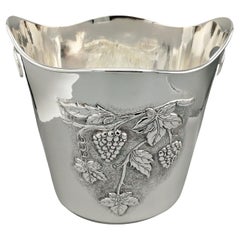GHILLI DI GIOVANELLA PAOLO ADOLFO Sterling Silver
to
3
3
3
3
3
2
2
1
3
3
3
3
3
3
Oliera Neoclassica Italiana in Argento Brescia 1820 circa Cestello con Ampolle
Located in Milano, MI
Oliera italiana in Argento di provenienza lombarda, della città di Brescia 1812/1872. Servizio da tavola, cestello ovale in argento contenente le ampolle dell'olio e dell'aceto. Su d...
Category
Antique Early 19th Century Italian Neoclassical Sterling Silver
Materials
Silver
19th Century Italian Milanese Neoclassical Silver Oil and Vinegar Cruet Set
Located in Milano, MI
Antique Milanese silver oil cruet consisting of an oval tray supported by four cast zoomorphic paw shaped feet; the edge of the tray is a ribbon decorated by...
Category
Antique Mid-19th Century Italian Neoclassical Sterling Silver
Materials
Silver
19th Century Italian Neoclassical Silver and Crystal Compote with Cover
By Cristoforo Corbella
Located in Milano, MI
From Milan a 19th century Italian silver and crystal compote bowl in good condition from a private collection. This antique Neoclassical covered compote bowl has a very fine hand-chased vegetal decoration and engraving, a lovely cast engraved silver 800/000 finial and shows silver-maker’s mark for Cristoforo Corbella active in the first half of 19th century in Milan, contrada degli Orefici 3194.
This antique silver compote of supreme craftsmanship stands on a three-lobed pedestal base with B L monogram engraved in the central part, features tripod legs decorated with neoclassical motifs, scrolls, flowers, rosettes supporting a circular upper ring adorned with elegant acanthus leafed piercing.
Engraved crystal cup and a cover finely engraved with geometrical and vegetal pattern, surmounted by a cast gem finial.
The following marks can be seen on the bottom of the foot and the upper edge of the compote, (the original descriptions are reported, as they appear on the documents of the State Archive of Milan):
1) “Forma eptagona. Globo col Zodiaco ed i setti (sic) Trioni” Heptagon form. Globe with the Zodiac and the seven Trioni (seven stars of the Ursa Major) Mark of the Guarantee Office in use in the Napoleonic Kingdom of Italy from 1812 for works with a title of 800 thousandths.
2) "Aratro" Plow Mark of the Guarantee Office in use in the Napoleonic Kingdom of Italy from 1812.
3) "insegna della Luna Piena...
Category
Antique Mid-19th Century Italian Neoclassical Sterling Silver
Materials
Crystal, Silver
Related Items
The Watts-Russell Candelabra. Rundell, Bridge & Rundell, London 1820
Located in London, GB
MARK OF PHILIP RUNDELL, LONDON, 1820, RETAILED BY RUNDELL, BRIDGE AND RUNDELL, BASED ON THE DESIGNS OF JOHN FLAXMAN, MODELLED BY EDWARD HODGES BAILY
Ea...
Category
Antique 1820s Sterling Silver
Materials
Silver
$692,466
H 24 in W 13.78 in D 13.78 in
Secchio champagne Italiano in argento Sterling 925 cesellato con motivi uva
By Arval Argenti Valenza
Located in VALENZA, IT
Secchio champagne in argento Sterling.
La forma è ovale a cono rovesciato.
Nel corpo del secchio sono stati realizzati sui lati piccoli 2 fori ovali adatti per il trasporto del sec...
Category
1990s Italian Other Wine Coolers
Materials
Sterling Silver
$4,192 / item
H 9.06 in W 9.06 in D 7.49 in
Early 19th Century Italian Neoclassical Silver Urn Vase Milan by Emanuele Caber
Located in Worpswede / Bremen, DE
A very decorative neoclassical silver urn stamped by the Italian silversmith Emanuele Caber, dating from around 1825. It has the Milan warranty stamp, and stamp of the silver finenes...
Category
Antique Early 19th Century Italian Neoclassical Sterling Silver
Materials
Silver
$2,874
H 10.24 in W 4.14 in D 4.14 in
Milanese Sterling Silver 20th Century Fountain Centrepiece
Located in London, GB
A Milanese sterling silver 20th century fountain centrepiece
Measures: Height: 33cm, width: 47cm, depth: 42cm.
This stunning centrepiece is an Italian sterling silver fountain, made in Milan in the twentieth century. The piece, set on fish-shaped legs, and decorated with mythical sea-monsters from whose mouths the water flows, consists of a rectangular shaped basin divided into four shell-shaped quadrants which are adorned with small silver crabs. A smaller basin...
Category
20th Century Italian Modern Sterling Silver
Materials
Sterling Silver
1820s Silver and Crystal Double Salt Cellar
Located in LA CIOTAT, FR
This exquisite antique French salt cellar is a stunning example of 19th-century silversmithing, combining refined craftsmanship with timeless elegance. Made of fine silver and crysta...
Category
Antique 19th Century French Sterling Silver
Materials
Crystal, Sterling Silver
Pair Italian Neoclassical Silver Salts With Hermes
Located in New York, NY
Pair Italian neoclassical silver salts with hermes. Pair of antique neoclassical sterling silver salt stands of Empire tripod form with pierced anthemion band supported by Hermès on ...
Category
Antique Early 19th Century Italian Neoclassical Sterling Silver
Materials
Crystal, Sterling Silver
19th Century Italian Sterling Silver Decorative Box
By Arval Argenti Valenza
Located in VALENZA, IT
Completely handmade sterling silver candy box.
The box is round and pot-bellied.
Embossments and chisels of flowers were made all over the body.
The box is divided into three sect...
Category
2010s Decorative Boxes
Materials
Sterling Silver
Antique Persian Arab Islamic Silver Engraved Calligraphy Quran Case Amulet 1820
Located in Portland, OR
A good antique early 19th century Persian silver engraved Holy Qur'an case amulet, circa 1820.
This type of Qur'an case is known in Persian as a Bazuband, these cases were worn on t...
Category
Antique 1820s Persian Islamic Sterling Silver
Materials
Silver
$695
H 0.99 in W 2.56 in D 2.29 in
Hans Hansen Sterling Silver Mid-Century Cruet Set
By Hans Hansen
Located in Hellerup, DK
A vintage sterling silver cruet set by Hans Hansen, crafted in 1963. The set comprises a round tray with a raised border, alongside teardrop-shaped salt and pepper shakers featuring ...
Category
Antique 1660s Danish Art Deco Sterling Silver
Materials
Sterling Silver
Gorham Sterling Silver Floral Repoussé Chambersticks, circa 1920-1930, a Pair
By Gorham
Located in Philadelphia, PA
A pair of Gorham sterling silver Chambersticks, circa 1920-1930.
A beautiful Repoussé pattern of roses, fans, shells, and scrolls. Each with a finger holder, charming for the bedsid...
Category
Vintage 1920s American American Classical Sterling Silver
Materials
Sterling Silver
$550 / set
H 2 in W 3.5 in D 4 in
Cowrie Shell Snuff Box c1820
Located in Tunbridge Wells, GB
Heading : Cowrie shell snuff box
Date : c1820
Period : George III / Regency
Origin : Most likely Scottish Provincial
Decoration : Silver mounted cowrie shell with monogram, parcel gi...
Category
Antique 1820s British Regency Sterling Silver
Materials
Silver
A Pair of Silver Shabbat Candlesticks, Germany, Circa 1820
Located in New York, NY
This exquisite pair of silver Shabbat candlesticks showcases the refined artistry of early 19th-century German silversmiths. Each candlesti...
Category
Antique 1820s German Sterling Silver
Materials
Silver
